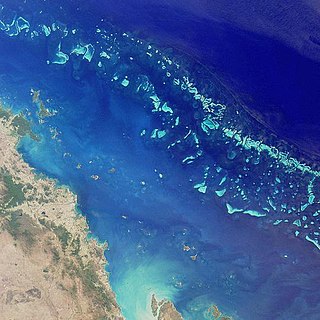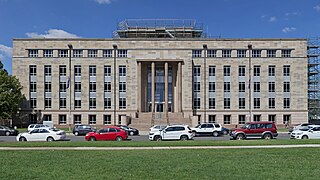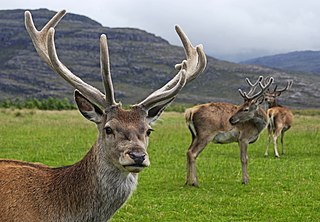Related Research Articles

Environmental protection is the practice of protecting the natural environment by individuals, groups and governments. Its objectives are to conserve natural resources and the existing natural environment and, where it is possible, to repair damage and reverse trends.
The Australian Department of the Environment was a department of the Government of Australia that existed between September 2013 and July 2016. The department was charged with responsibility for developing and implementing national policy, programs and legislation to protect and conserve Australia's environment and heritage.

The New South Wales Office of Environment and Heritage (OEH), a former division of the Government of New South Wales between April 2011 and July 2019, was responsible for the care and protection of the environment and heritage, which includes the natural environment, Aboriginal country, culture and heritage, and built heritage in New South Wales, Australia. The OEH supported the community, business and government in protecting, strengthening and making the most of a healthy environment and economy within the state. The OEH was part of the Department of Planning and Environment cluster and managed national parks and reserves.
The Register of the National Estate was a heritage register that listed natural and cultural heritage places in Australia that was closed in 2007. Phasing out began in 2003, when the Australian National Heritage List and the Commonwealth Heritage List were created and by 2007 the Register had been replaced by these and various state and territory heritage registers.
The New South Wales Department of Planning and Environment (DPE) is a department of the New South Wales Government, responsible for effective and sustainable planning to support the growth in the state of New South Wales, Australia. It makes plans based on evidence for the state's cities and regions, working with the community, business and local government to create places for people in NSW to live, work and spend their leisure time, while ensuring good access to transport and other services like shops and restaurants. The department is also responsible for the evidence-based assessment of state significant development applications.

The Australian National Heritage List or National Heritage List (NHL) is a heritage register, a list of national heritage places deemed to be of outstanding heritage significance to Australia, established in 2003. The list includes natural and historic places, including those of cultural significance to Indigenous Australians such as Aboriginal Australian sacred sites. Having been assessed against a set list of criteria, once a place is put on the National Heritage List, the provisions of the Environment Protection and Biodiversity Conservation Act 1999 apply.

The Environment Protection and Biodiversity Conservation Act 1999(Cth) is an Act of the Parliament of Australia that provides a framework for protection of the Australian environment, including its biodiversity and its natural and culturally significant places. Enacted on 17 July 2000, it established a range of processes to help protect and promote the recovery of threatened species and ecological communities, and preserve significant places from decline. The Act is as of June 2020 administered by the Department of Agriculture, Water and the Environment. Lists of threatened species are drawn up under the Act, and these lists, the primary reference to threatened species in Australia, are available online through the Species Profile and Threats Database (SPRAT).

The Australian Heritage Council is the principal adviser to the Australian Government on heritage matters. It was established on 19 February 2004 by the Australian Heritage Council Act 2003. The Council replaced the Australian Heritage Commission as the Australian Government's independent expert advisory body on heritage matters when the new Commonwealth heritage system was introduced in 2004 under amendments to the Environment Protection and Biodiversity Conservation Act 1999. The Council assesses nominations for the Australian National Heritage List and the Commonwealth Heritage List. The Minister may ask the Council for advice on action that he may take in relation to the List of Overseas Places of Historic Significance to Australia.
Manitoba Environment and Climate is a department of the Government of Manitoba that is responsible for the management and protection of Manitoba's wildlife, water, species at risk, forestry, and other matters related to environmental stewardship and Manitoba's biodiversity of natural resources.

The Minister for Resources is an Australian Government cabinet position which is currently held by Madeleine King following the swearing in of the full Albanese ministry on 1 June 2022.

The Minister for Climate Change and Energy is a portfolio in the Government of Australia. The current Minister is Chris Bowen. The minister administers his or her portfolios through the Department of Climate Change, Energy, the Environment and Water.

The Commonwealth Heritage List is a heritage register established in 2003, which lists places under the control of the Australian government, on land or in waters directly owned by the Crown. Such places must have importance in relation to the natural or historic heritage of Australia, including those of cultural significance to Indigenous Australians. National heritage sites on the list are protected by the Environment Protection and Biodiversity Conservation Act 1999.
The Australasian Underwater Cultural Heritage Database (AUCHD) is an online, searchable database containing data on shipwrecks, aircraft that have been submerged underwater or wrecked on the shore, and other artefacts of cultural significance which are or have been underwater. It includes what used to be called the Australian National Shipwreck Database (ANSDB), originally developed by the Australasian Institute of Maritime Archaeology in December 2009, now significantly expanded to include other objects. The database was hosted and maintained by the Department of the Environment and Energy until the environment functions of that department, including AUCHD, were taken over by the Department of Agriculture, Water and the Environment on 1 February 2020.
The Environmental Defender's Office (NSW) in Sydney, New South Wales, was one of nine EDO offices located across Australia, formerly known as the Australian Network of EDOs (ANEDO).
The Department of the Environment, Water, Heritage and the Arts was an Australian Government department that existed between December 2007 and September 2010.
The Department of Sustainability, Environment, Water, Population and Communities was an Australian government department that existed between September 2010 and September 2013.

This article gives an overview of the structure of environmental and cultural conservation in Scotland, a constituent country of the United Kingdom.

The Underwater Cultural Heritage Act 2018 is an Australian Act of Parliament designed "to protect shipwrecks, sunken aircraft and their associated artefacts, that occurred 75 or more years ago, regardless of whether their location is known". Other underwater heritage items, and more recent shipwrecks or aircraft, may be protected through a declaration under the Underwater Heritage Act, and some sites also have a protected zone around them. The federal government works in collaboration with State and Territory Government agencies to protect and conserve Australia's underwater heritage.
The Australian Department of Agriculture, Water and the Environment (DAWE) was an Australian Government department which operated from 1 February 2020 until 30 June 2022. It represented Australia's national interests in agriculture, water and the environment.
References
- ↑ Anderson, Stephanie (20 July 2016). "Election 2016: Malcolm Turnbull unveils ministry with Christopher Pyne, Greg Hunt on the move". Australian Broadcasting Corporation. Archived from the original on 24 August 2016.
- ↑ "Administrative Arrangements Order - 5 December 2019" (PDF). Department of Prime Minister and Cabinet. Commonwealth of Australia. 5 December 2019. Archived (PDF) from the original on 3 February 2020. Retrieved 3 February 2020.
- ↑ Morrison, Scott. "Media Release: 5 December 2019 - New structure of Government Departments". Prime Minister of Australia. Commonwealth of Australia. Archived from the original on 14 December 2019. Retrieved 3 February 2020.
- ↑ Administrative Arrangements Order – amendment made 19 July 2016, Australian Government, archived from the original on 30 August 2016
- ↑ Administrative Arrangements Order, Australian Government, archived from the original on 13 September 2016, retrieved 30 August 2016
- ↑ "Australasian Underwater Cultural Heritage Database". Australian Government. Dept of the Environment and Energy. Archived from the original on 14 October 2019. Retrieved 14 October 2019.
- ↑ "Databases and applications". Australian Government. Dept of the Environment and Energy. Archived from the original on 16 October 2019. Retrieved 15 October 2019.

